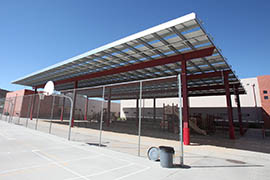Cronkite News has moved to a new home at cronkitenews.azpbs.org. Use this site to search archives from 2011 to May 2015. You can search the new site for current stories.
Utility’s incentive program enables hundreds of schools to go solar
PHOENIX – As students cavort around Sunnyslope Elementary School’s playground, a shade structure high above the slides and monkey bars helps harness the sun’s power.
Since December 2012, when 1,416 solar panels went into use over the playground and parking lot as well as the roof, the system has provided enough power in three months to meet all of this school’s energy needs, said Sue Pierce, the Washington Elementary School District’s director of facility planning and energy.
“To be able to power the school during the school year with all solar was quite an accomplishment,” she said.
The 411-kilowatt system came courtesy of Arizona Public Service Co.’s Renewable Energy Incentive program, which has provided solar to more than 300 schools in 70 districts. Paid for by APS incentives, the systems are installed and owned by third-party companies.
Participating schools and districts must commit to buying back electricity generated by their systems at a reduced rate.
The program, aimed at reducing the costs of installing solar systems in homes and businesses, is available to all APS customers, said Rex Stepp, the utility’s leader of renewable programs.
Through the Schools and Government Program, Arizona schools have received more than $200 million in solar incentives to produce more than 100 megawatts of solar energy, he added.
“There’s a lot of interest from school districts across our region for solar power,” Stepp said. “We know that the customers want solar energy, so we want to be able to make sure that we can provide them with what they need.”
Following an application process, the Washington Elementary School District was awarded some of the program’s largest incentives to be used at Sunnyslope and Mountain View elementary schools, Pierce said.
Ultimately, the district paid nothing for the installation of the solar system because it provided land for the third-party provider, Tioga Energy, as part of a solar services agreement, Pierce said.
The electricity is sold to the schools at less than 7 cents per kilowatt-hour, Pierce said. The average utility rate for schools in the district is about 9 cents per kilowatt-hour, she added.
The solar panels aren’t just saving the district money though; they’re allowing teachers to introduce students to energy conservation at an early age.
“On any kind of field trip, the students now look for solar in other buildings,” Pierce said. “It’s just built an amazing awareness.”
An interactive kiosk is set up in Sunnyslope’s library to provide students with visualizations of how much energy is created daily. The students are also able to bring up the data on classroom computers to use in studies and research projects that focus on energy and the environment.
“It’s really important to help them understand the role they play in handling and managing the environment for today and the future,” Pierce said. “Schools are the place to teach and model sustainability and conservation.”









